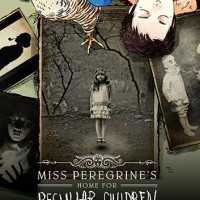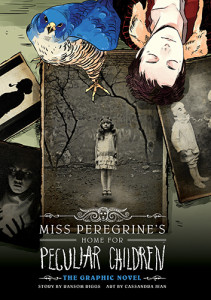Review: Miss Peregrine’s School for Peculiar Children (Graphic Novel)

Miss Peregrine’s School for Peculiar Children by Ransom Riggs and Cassandra Jean
- Publisher: Yen Press
- Format/Price: Hardcover, 240 pages, with full-color. $19.99
- Published: October 29, 2013
I hadn’t read the original prose novel before diving into the graphic novel, so I can’t speak to whether it lives up to the mood set by its source material, but the graphic novel version of Miss Peregrine’s Home for Peculiar Children was a fast-paced, entertaining read that was just creepy enough to be engaging, but not so over-the-top supernatural as to be just another cloying and annoying ‘let’s write a kinda sexy YA story about vampires and monsters and stuff!” book.
If you’re not familiar with this story, here’s a quick summary. Modern day teen Jacob grew up listening to his grandfather’s seemingly fanciful tales of his childhood spent at a very unusual boarding school, where some of his friends could levitate, turn invisible or were super strong. (No, this is not the X-Men, silly).
One day, Jacob discovers his grandfather left mortally wounded by a demon-like monster. With his dying breath, Jacob’s grandfather gives him some cryptic instructions and tells him to seek out Miss Peregrine’s home, which is located on a remote island off the coast of Wales. Jacob goes there with his father, hoping to find some answers about his grandfather’s past and his mysterious death. He’s disappointed to discover that the mansion so vividly described by his grandfather is pretty much abandoned, left in ruins after it was bombed in WWII. But is it *really* abandoned? Soon enough, Jacob discovers just how peculiar Miss Peregrine and her young charges really are… and finds out he might be “peculiar” like them too.
Like I said, I haven’t read the novel, so I can’t compare the pacing and mood that Riggs sets with his prose, but overall, reading this graphic novel was a breeze — it rolled along at a good clip, and managed to keep my interest without bogging me down with too much blah-de-blah explaining how the whys, hows, and why nots of this book’s magical world.
Compared to her prior work adapting Beautiful Creatures: The Graphic Novel, where her art seemed too spare and minimal to truly capture the menace and mystery of that Southern Gothic romance/adventure story, Cassandra Jean seems to have hit her artistic stride here with Miss Peregrine’s.
This is largely due to her clever use of full-color pages with flowing watercolors interspersed with more monochromatic pages to illustrate the two worlds that Jacob exists in: the ‘real world,’ and the world trapped in time at Miss Peregrine’s mansion. Jean also manages to tell a lot with wordless panels; how the characters look at and react to each other, and how she uses color / dark and light to set a mood that often veers between joyous and ominous moments.
Jean’s page composition is also a bit more self-assured in this book, with some nice use of all black / all white pages and energetic, scratchy penlines to move the story along. I’m not entirely sure that her very spare, modern style of drawing truly captures the mood of the 1940’s-era scenes, much less the inherent creepiness/suspense of the story, but she does manage to tell the story and keep my interest from start to finish, which is not always a given.
While she’s pretty adept at capturing emotional / quieter conversational scenes, Jean’s action/fight scenes are a little hard to follow at times, and can sometimes seem abrupt/stiffly choreographed. However, they don’t overly detract from the story, so maybe that’s a wash.
In general, Riggs does a pretty good job with spinning this supernatural yarn –there’s just enough surprises to keep you guessing, enough action and suspense to keep you turning the pages, and when all’s said and done, he gives readers a fairly satisfying ending — for now, since this depicts the first of what looks to be a series of novels about Jacob and the “peculiar” world that Riggs has created for him and his friends.
On a practical note, it’s very nice to see that Yen Press opted to present this book in hardcover — a very classy package.
Overall, a fairly entertaining read. Not super deep, and not my all-time fave, but it should please fans of the prose novel series. If it does that, this graphic novel accomplished all it set out to do.

